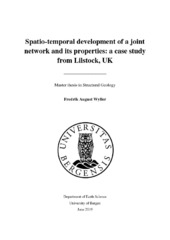| dc.description.abstract | The aim of this study is to investigate the spatial distribution and scaling properties of various joint sets, with particular focus on the temporal development of network properties and the influence of pre-existing structures. This is mainly done through analysis of UAV imagery of a limestone bed surface exposed in the hanging wall of a normal fault on wave-cut platforms along the Somerset Coast, UK. Networks of bed-bound joints are known to develop extensively in layered sequences during exhumation. Joint formation can be controlled by remote stresses, local stresses and structural inheritance, but there is a lack of understanding about how these factors influence joint geometries and spatio-temporal development of network architecture. This study assesses orientation, length scaling and topological properties of joint traces in order to identify 11 joint sets. The relative chronology of these joint sets is inferred from abutting relationships, allowing for an analysis of the development of geometrical and topological network properties. The studied network contains a set of fan-like curving joints, which pre-date all other joint sets. The curvature of these joints is interpreted to result from localized stress perturbations along the fault plane, attributed to intersecting faults in the footwall. Joint propagation is affected by structural inheritance, with joints preferentially reactivating older suitably oriented veins. Different joint sets exhibit different length scaling properties. Old joint sets tend to follow power-law length scaling distributions, whereas young sets tend to be described by log-normal or negative exponential scaling laws. Joint geometries and distribution of network properties is controlled by the spatial arrangement of earlier veins and joints. In particular, the fan-structure of curving joints controls spatial distribution of subsequent joint formation. Near isotropic horizontal tension is responsible for curving joints during later stages of network evolution, resulting in block break-up patterns controlled by stress perturbations around pre-existing joints. The topological analysis indicates that the network evolves from consisting predominantly of isolated I-nodes and becomes progressively interconnected with each new joint set due to the formation of abutting Y-nodes. Formation of crossing X-nodes is mainly associated with early joints that reactivate veins, causing different topological pathways for different areas of the fracture network. The findings from this study contribute to the understanding of how joint networks development in exhumed basins and elucidate how older structures control joint formation and may cause strong heterogeneities in joint network properties. | en_US |
